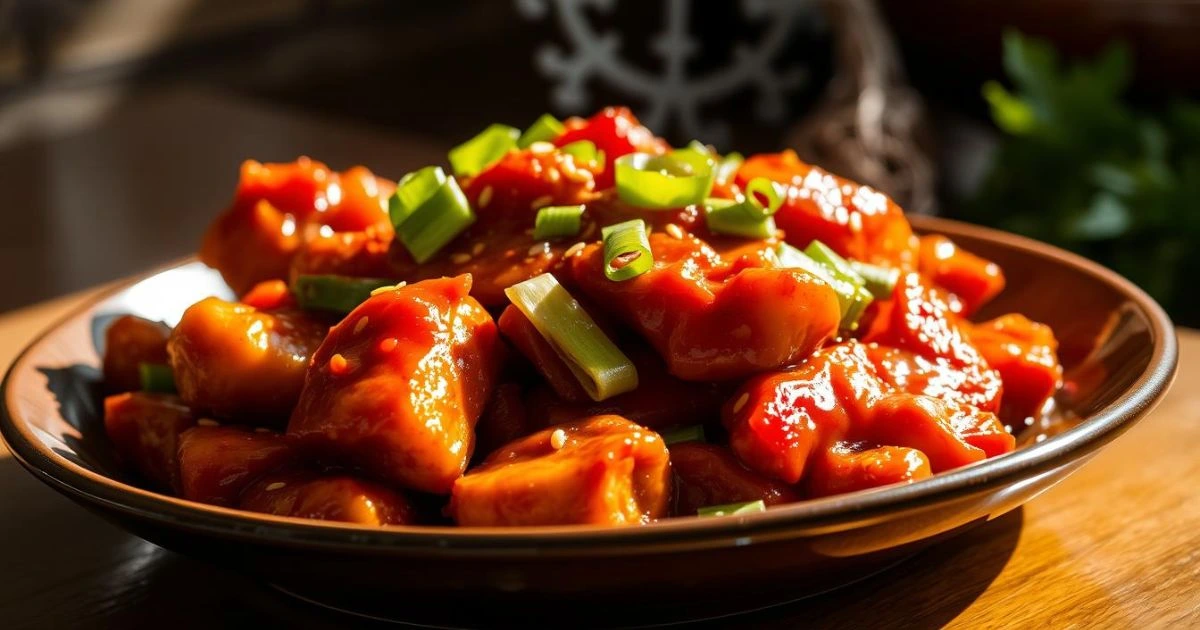Explore the world of Hunan chicken, a spicy Chinese food loved by many in the U.S. It’s a mix of traditional Chinese tastes and new cooking ideas.
Hunan chicken is more than just takeout. It started as a Chinese-American twist. The dish has tender chicken in a bold, spicy sauce that excites your taste buds.
The dish’s magic is in its flavors. It combines crisp veggies and juicy chicken with a spicy sauce. This brings Hunan’s bold cooking style right to your plate. Each recipe is a unique trip through Chinese cooking traditions.
Restaurants all over America love serving Hunan chicken. It’s a favorite for those who love spicy food or want to try something new. This dish promises a meal you won’t forget.
Table of Contents
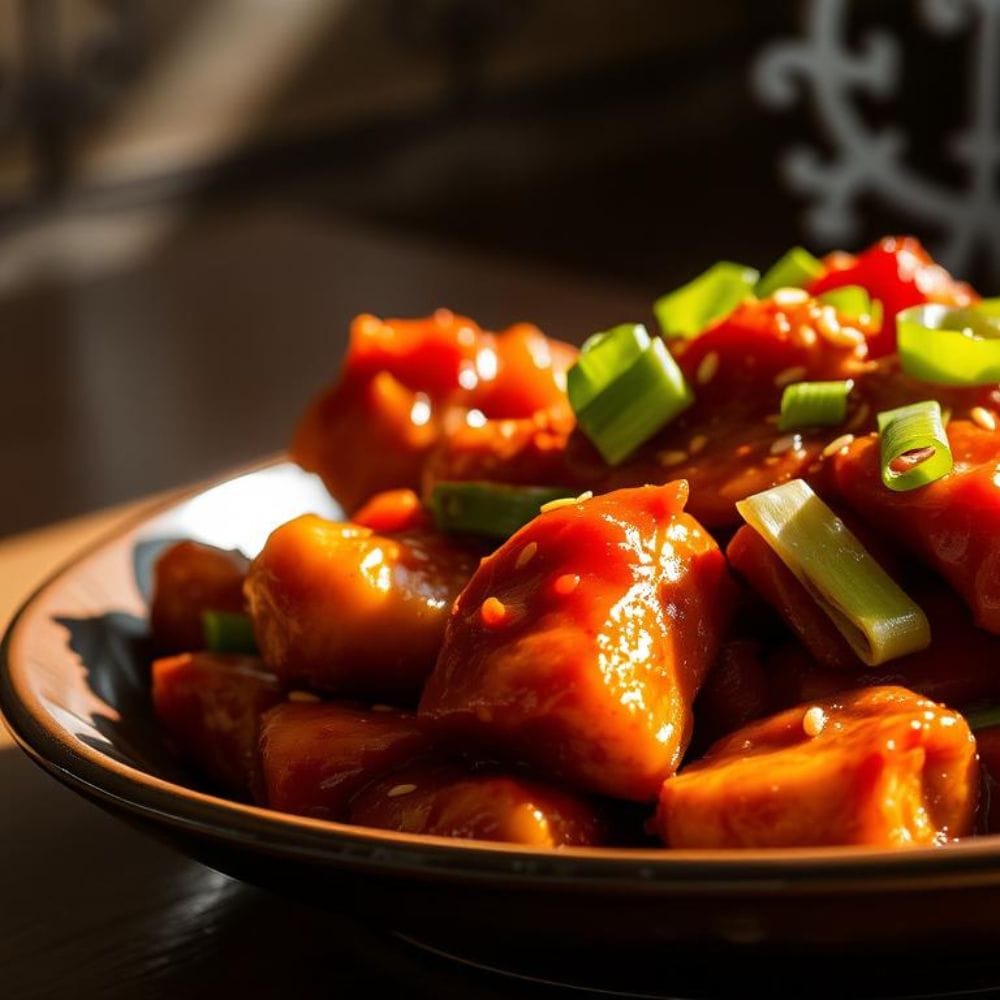
Hunan Chicken
Ingredients
Equipment
Method
- Marinate the Chicken: In a bowl, combine soy sauce, rice wine, cornstarch, garlic, and ginger. Add chicken pieces and marinate for 30 minutes to 2 hours in the refrigerator.
- Prepare Vegetables: Cut bell peppers, zucchini, and carrots into uniform slices. Prepare bamboo shoots and mushrooms if using.
- Make the Sauce: In a small bowl, mix dark soy sauce, light soy sauce, oyster sauce, rice vinegar, chicken broth, chili paste, sugar, and cornstarch. Set aside.
- Cook the Chicken: Heat a wok over high heat. Add oil and stir-fry the marinated chicken until golden and nearly cooked through. Remove and set aside.
- Stir-Fry Vegetables: In the same wok, add a bit more oil. Stir-fry dried chili peppers and Sichuan peppercorns for 10–15 seconds until fragrant. Add harder vegetables first (carrots, bamboo shoots), followed by softer ones (bell peppers, zucchini). Stir-fry for 2–3 minutes.
- Combine Everything: Return chicken to the wok. Pour in the sauce and toss everything quickly to coat. Stir-fry for another 2–3 minutes until sauce thickens and everything is evenly glazed.
- Serve: Garnish with chopped scallions and sesame seeds. Serve hot with steamed jasmine rice or noodles.
Notes
- For milder spice, reduce or deseed the dried red chili peppers.
- Chicken thighs give a juicier texture than breasts.
- Always pat the chicken dry before cooking to achieve a good sear.
- To replicate restaurant-style “wok hei,” cook over very high heat and keep ingredients moving constantly.
- Pair with steamed jasmine rice, egg drop soup, or vegetable spring rolls for a balanced meal.
Understanding Authentic Hunan Cuisine Origins
Hunan cuisine comes from south-central China, known for its bold flavors and intense heat. Exploring authentic Hunan dishes takes you back to a time of rich agricultural lands and traditional cooking methods.
The essence of Hunan cuisine lies in its vibrant traditional Chinese spices. These spices set it apart from other cooking styles. Farmers and chefs work together to create meals that highlight fresh, local ingredients.
Traditional Hunan Cooking Methods
Hunan cuisine’s cooking methods show a strong connection to farming. Chefs use several unique techniques:
- Smoking and curing meats
- Stir-frying with intense heat
- Fermenting vegetables and proteins
- Using clay pot cooking techniques
Regional Flavor Characteristics
Hunan cooking is known for its pure heat and complex flavors. Unlike Sichuan cuisine, Hunan dishes focus on the direct chili pepper heat.
| Characteristic | Hunan Cuisine | Sichuan Cuisine |
| Spice Profile | Pure chili heat | Numbing and spicy |
| Primary Seasoning | Fresh chilies | Sichuan peppercorns |
| Cooking Style | Direct, intense | Complex, layered |
Difference from Sichuan Cuisine
While both are spicy, Hunan cuisine is known for its straightforward heat. Your taste buds will feel a direct, powerful chili sensation. This is different from the complex tingling of Sichuan spices.
Essential Ingredients for Hunan Chicken
To make the best Hunan chicken, start with top-notch ingredients. These ingredients bring the true taste of traditional Chinese spices to your dish. Begin your cooking journey by knowing the key parts that make this recipe stand out.
Choosing the right chicken is the first step. Use boneless, skinless chicken thighs for the best flavor and tenderness. Fresh ingredients are key to getting that authentic Hunan taste.
- Protein Base:
- Boneless chicken thighs
- Chicken breasts (alternative option)
- Essential Traditional Chinese Spices:
- Dried red chili peppers
- Sichuan peppercorns
- Fresh garlic
- Fresh ginger
Aromatics are vital for Hunan’s unique flavor. Fresh ginger and garlic give the dish its base taste. Traditional spices like dried chili peppers add heat and depth.
- Sauce Ingredients:
- Dark soy sauce
- Light soy sauce
- Rice vinegar
- Shaoxing wine
When making your Hunan chicken, pick fresh, high-quality ingredients. The mix of traditional Chinese spices turns simple items into a memorable dish. It will take your taste buds on a trip to Hunan province.
The Perfect Hunan Sauce Components
Making an authentic Hunan chicken sauce is key. It’s what makes your homemade Chinese food special. You need to get the heat, depth, and complexity just right.
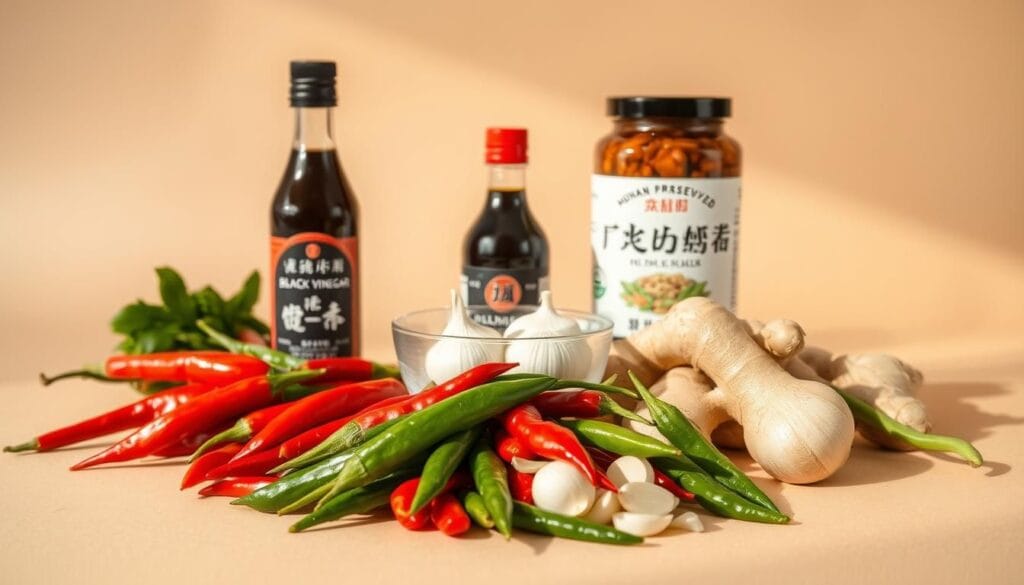
The sauce is more than flavor; it’s an art. It turns simple ingredients into a dish that’s truly amazing. Knowing each part helps you make a Hunan chicken that stands out.
Base Sauce Ingredients
The base of your sauce needs some important ingredients. They add a rich umami flavor:
- Soy sauce for depth
- Oyster sauce for sweetness
- Rice wine for complexity
- Chicken broth for moisture
Spice and Heat Elements
To make your dish spicy, add these heat components:
- Dried red chili peppers
- Chili paste for intense warmth
- Szechuan peppercorns for numbing sensation
- Garlic and ginger for aromatic spiciness
Balancing Flavors
Harmonizing flavors is the secret to great homemade Chinese food. Cornstarch thickens the sauce, making it glossy. This coating sticks well to chicken and veggies. A bit of sugar can balance out the heat, while vinegar adds a tangy touch.
Remember, the Hunan sauce should match your taste. Start with classic recipes and tweak the spice to your liking.
Preparing and Marinating the Chicken
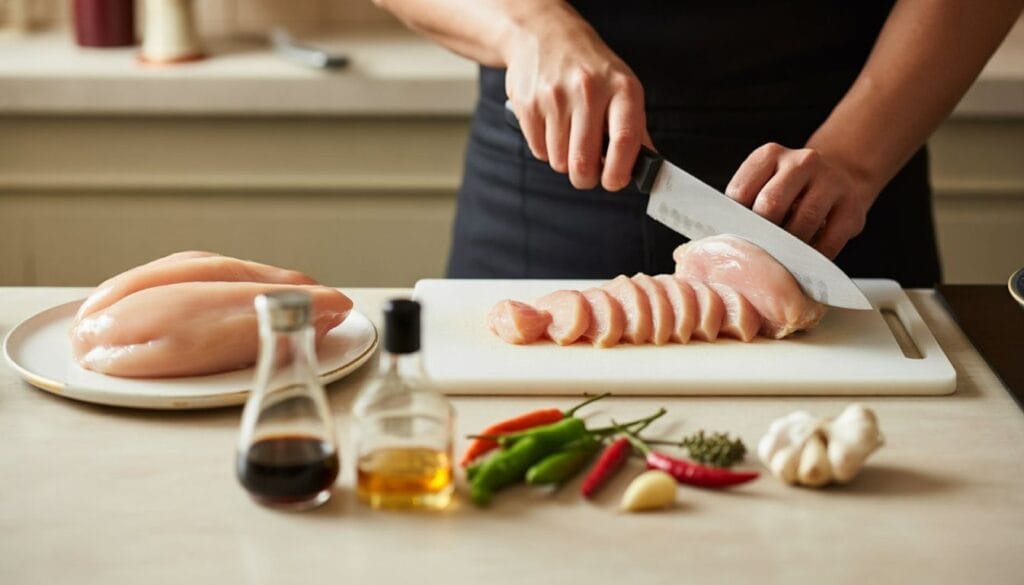
Starting with the best Hunan chicken recipe means getting the chicken right. Choose the right cut and marinate it well. Chicken thighs or breasts are great, with thighs being more flavorful and tender.
The marinade is key for rich, true flavors. A classic Hunan chicken marinade has:
- Soy sauce for depth and saltiness
- Rice wine for subtle complexity
- Cornstarch to help seal in moisture
- Minced garlic for aromatic intensity
- Ginger for a warming undertone
When cutting the chicken, make sure the pieces are the same size for even cooking. Slicing against the grain makes the meat tender and absorbs the marinade well. Aim for pieces about 1-2 inches in size for the best texture.
Marinating time is important for flavor. Let the chicken marinate for 30 minutes to 2 hours in the fridge. This lets the flavors soak into the meat, making your dish more complex and tasty.
Pro tip: Always pat the chicken dry before cooking to achieve a perfect sear and prevent steaming.
Vegetable Selection and Preparation
Creating authentic Hunan dishes starts with choosing the right vegetables. The right mix can make your Asian recipes stand out. Your vegetable selection is key to capturing Hunan’s true flavors.
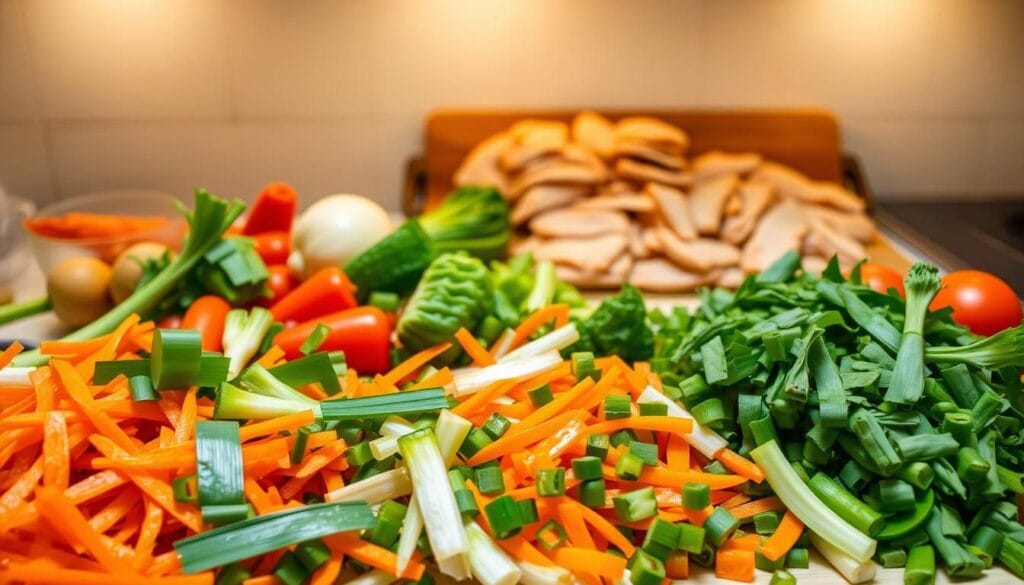
Best Vegetables for Authentic Flavor
For Hunan chicken, pick vegetables that match its bold taste. The best mix includes:
- Bell peppers (red and green)
- Zucchini
- Carrots
- Bamboo shoots
- Wood ear mushrooms
Precision Cutting Techniques
Proper cutting is crucial for even cooking and texture. Aim for uniform pieces that cook fast and stay crisp.
| Vegetable | Cutting Technique | Ideal Size |
| Bell Peppers | Diagonal slice | 1-inch pieces |
| Zucchini | Julienne | Thin strips |
| Carrots | Bias cut | 1/4-inch thick |
Maintaining Vegetable Texture and Crunch
To keep vegetables crunchy, follow these tips:
- Stir-fry vegetables briefly at high heat
- Add vegetables near the end of cooking
- Avoid overcrowding the wok
Mastering vegetable prep will make your Hunan chicken a hit. It will turn a simple meal into a top-notch dish in popular Asian recipes.
Mastering the Hunan Chicken Cooking Process
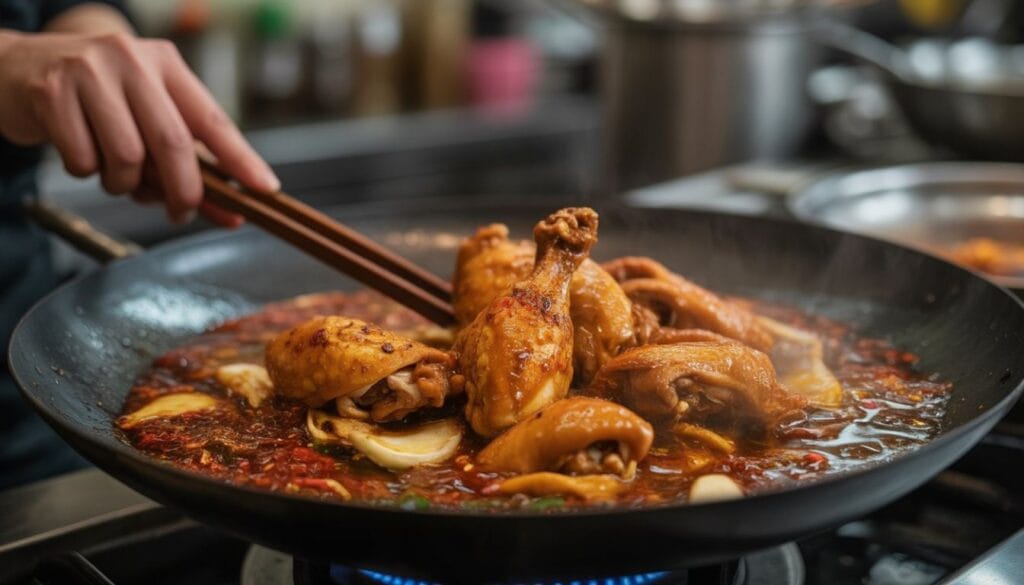
To make the best Hunan chicken at home, you need to be precise and know traditional Chinese cooking. Your journey in making homemade Chinese food begins with learning the stir-frying method. This method is key to making this dish delicious.
The cooking process has several important steps. These steps help bring out authentic flavors and the right texture:
- Velveting the chicken to make it tender
- Preparing vegetables with the right cutting techniques
- Using high heat in a wok
- Layering ingredients for the best flavor
Begin by heating your wok to a high temperature. The secret to Hunan chicken like restaurants is quick, intense cooking. This method seals in flavors and keeps ingredients crisp.
When cooking vegetables, timing is everything. Start with harder vegetables to keep them crunchy. Add softer vegetables last to avoid them getting mushy.
The key to authentic Hunan chicken is balancing heat, speed, and ingredient preparation.
Finally, mix the cooked chicken and vegetables with the spicy Hunan sauce. Stir quickly to coat everything evenly. This way, every bite will have a burst of traditional Chinese flavors.
Tips for Achieving Restaurant-Quality Results
To make your homemade Chinese food as good as a restaurant’s, you need to master some key cooking techniques. Professional chefs know the secrets to making Hunan chicken that tastes just like it does in China.
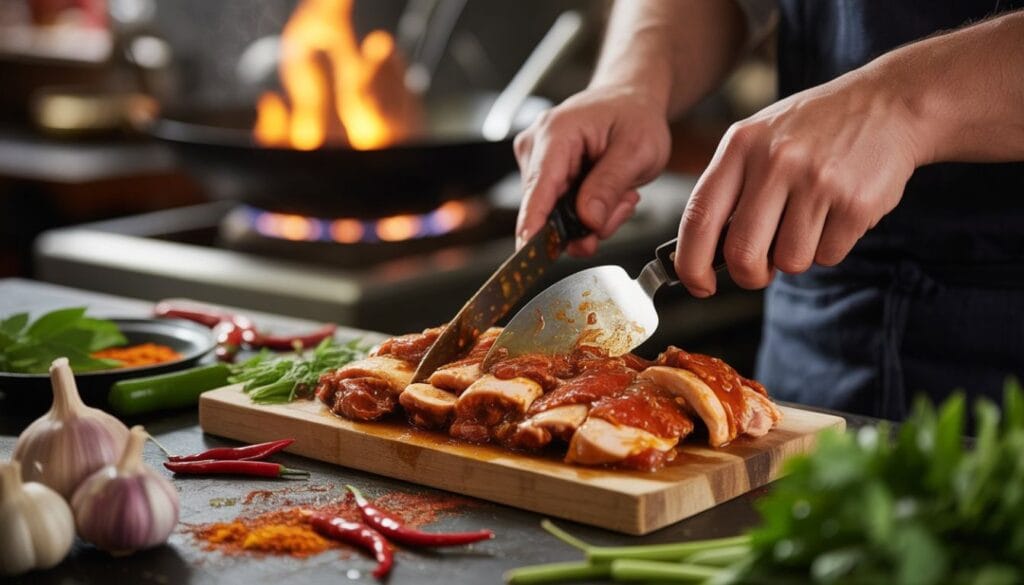
Getting your Hunan chicken right at home means paying close attention to a few important cooking details. These details can turn a simple dish into a masterpiece.
Temperature Control Mastery
The secret to making your dish restaurant-quality is controlling the heat. Your wok needs to be extremely hot before you start cooking. This high heat:
- Quickly sears the chicken
- Makes vegetables crisp
- Locks in flavors
Precise Timing and Ingredient Sequence
Creating great homemade Chinese food means knowing the right order to add ingredients. Timing is crucial when making Hunan chicken:
- Marinate the chicken first
- Prepare the vegetables ahead of time
- Cook the proteins before the vegetables
- Add the sauce last to avoid burning
Professional Wok Techniques
Mastering wok hei – the wok’s breath – is key. Here are some professional techniques to practice:
- Use a continuous tossing motion
- Keep ingredients moving all the time
- Cook quickly and with confidence
With practice, your kitchen will become a professional cooking space. You’ll be able to make a Chinese takeout favorite that’s as good as any restaurant’s.
Serving Suggestions and Pairings
Hunan chicken is a favorite in Asian recipes. It can be the star of your meal at home. The right way to serve it makes it even more special.
Steamed white rice is a classic choice to go with Hunan chicken. It helps cool down the spicy flavors. The rice soaks up the sauce, making each bite a perfect mix of taste and texture.
Perfect Serving Accompaniments
- Steamed jasmine rice
- Stir-fried vegetables
- Egg drop soup
- Vegetable spring rolls
Presentation Tips
To make your Hunan chicken look like a restaurant dish, serve it in a wide, shallow bowl. Top it with fresh scallions and a bit of sesame seeds. This not only looks good but also adds more flavor.
| Pairing | Flavor Complement |
| Jasmine Rice | Absorbs spicy sauce |
| Egg Drop Soup | Mild contrast to spicy chicken |
| Vegetable Spring Rolls | Crispy texture balance |
For a full meal, add side dishes that match Hunan chicken’s bold taste. These ideas will make your Chinese meal at home unforgettable.
Conclusion
Exploring Hunan chicken is a fun journey into spicy Chinese food. It changes how you cook at home. This dish is more than just food; it opens a door to Hunan’s rich cooking traditions.
By learning its secrets, you can make food that wows everyone. You’ll impress your family and friends with your homemade Chinese dishes.
Hunan chicken is known for its bold flavors and easy recipe. To master it, you need practice, patience, and a love for real spices and cooking ways. Every try gets you closer to the perfect mix of heat, tanginess, and depth.
Remember, cooking is always learning. Hunan chicken is a great start to exploring Chinese regional foods. Your new skills will let you try more traditional recipes. You’ll grow your cooking skills and learn about different cultures with every meal.
Start your journey to make this amazing dish. With each dish you make, you’ll learn more about Hunan’s unique flavors and cooking methods. Your kitchen will become a place of discovery, connecting you to cooking traditions from far away.
FAQ
What is Hunan chicken?
Hunan chicken is a favorite dish in Chinese-American cuisine. It comes from Hunan province in China. It’s known for its bold, spicy taste. The dish mixes chicken, fresh veggies, and a hot sauce with chili peppers, garlic, and spices.
How spicy is authentic Hunan chicken?
Hunan chicken is very spicy. It uses fresh chilies and fermented ingredients for a strong flavor. You can make it less spicy if you prefer.
What makes Hunan chicken different from Sichuan chicken?
Hunan chicken is spicier and uses fresh chilies. Sichuan chicken has a numbing spiciness from Sichuan peppercorns. It also has a more complex flavor with extra spices.
What are the key ingredients in Hunan chicken?
Hunan chicken needs chicken, bell peppers, onions, garlic, and chili peppers. It also includes soy sauce, rice vinegar, ginger, and scallions.
Can I make Hunan chicken less spicy?
Yes, you can make it less spicy. Use fewer chili peppers or remove seeds. You can also add sugar to balance the heat.
What is the best way to cook Hunan chicken at home?
Cook it in a wok or large skillet at high heat. Marinate the chicken first. Stir-fry veggies quickly and then cook the chicken. Finish with the spicy sauce.
What should I serve with Hunan chicken?
Serve it with steamed white rice. You can also try jasmine rice, brown rice, or noodles. Adding stir-fried veggies or a light soup can balance the flavors.
Is Hunan chicken a healthy dish?
Hunan chicken can be healthy with lean chicken and lots of veggies. It’s high in protein and has health benefits from spices. But, restaurant versions can be high in sodium and calories. Making it at home lets you control the ingredients.
There are no reviews yet. Be the first one to write one.

